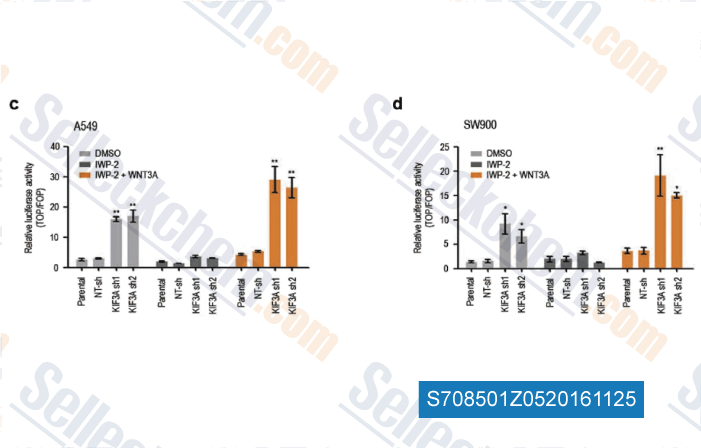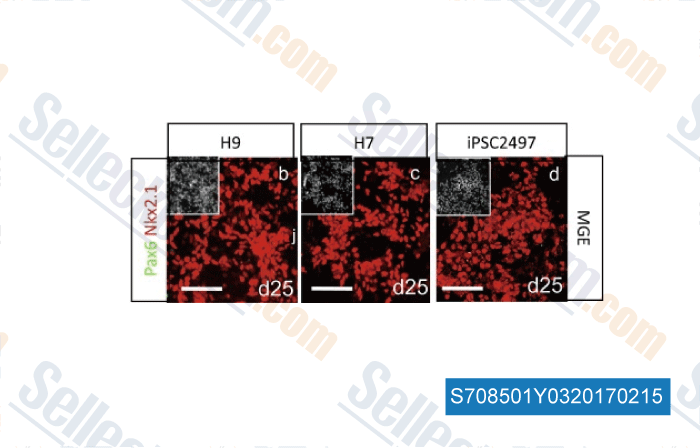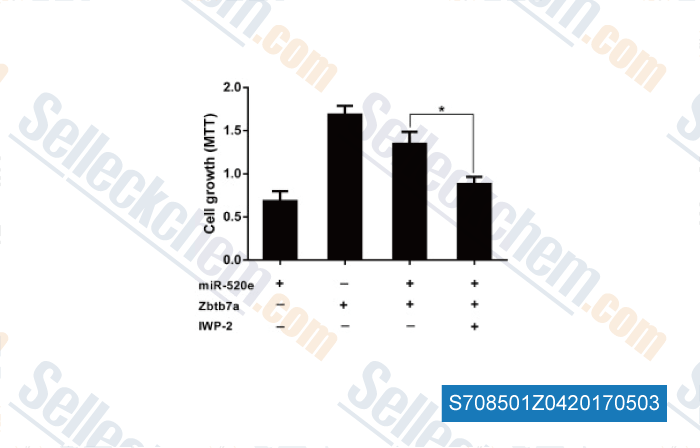|
Toll Free: (877) 796-6397 -- USA and Canada only -- |
Fax: +1-832-582-8590 Orders: +1-832-582-8158 |
Tech Support: +1-832-582-8158 Ext:3 Please provide your Order Number in the email. |
Technical Data
| Formula | C22H18N4O2S3 |
||||||
| Molecular Weight | 466.6 | CAS No. | 686770-61-6 | ||||
| Solubility (25°C)* | In vitro | DMF | 12.5 mg/mL (26.78 mM) | ||||
| DMSO | 10 mg/mL (21.43 mM) | ||||||
| Water | Insoluble | ||||||
| In vivo (Add solvents to the product individually and in order) |
|
||||||
|
* <1 mg/ml means slightly soluble or insoluble. * Please note that Selleck tests the solubility of all compounds in-house, and the actual solubility may differ slightly from published values. This is normal and is due to slight batch-to-batch variations. * Room temperature shipping (Stability testing shows this product can be shipped without any cooling measures.) |
|||||||
Preparing Stock Solutions
Biological Activity
| Description | IWP-2 is an inhibitor of Wnt processing and secretion with IC50 of 27 nM in a cell-free assay, selective blockage of Porcn-mediated Wnt palmitoylation, does not affect Wnt/β-catenin in general and displays no effect against Wnt-stimulated cellular responses. IWP-2 specifically inhibits CK1δ. | ||||
|---|---|---|---|---|---|
| Targets |
|
||||
| In vitro | IWP-2 is useful in both regenerative medicine and anticancer efforts. IWP-2 inactivates Porcn, a membrane-bound O-acyltransferase (MBOAT), and selectively inhibits palmitoylation of Wnt. IWP-2 blocks Wnt-dependent phosphorylation of Lrp6 receptor and Dvl2, and β-catenin accumulation. [1] |
||||
| Features | Selective inhibitor of Porcn-mediated Wnt secretion. |
Protocol (from reference)
| Cell Assay: |
|
|---|---|
| Animal Study: |
|
References
|
Customer Product Validation

-
Data from [ , , Sci Rep, 2016, 6:32770. ]

-
Data from [ , , Methods, 2016, 101:103-12. ]

-
Data from [ , , Biochem Biophys Res Commun, 2017, 486(1):49-56 ]
Selleck's IWP-2 Has Been Cited by 146 Publications
| Persistent Wnt signaling affects IVF embryo implantation and offspring metabolism [ Sci Bull (Beijing), 2025, S2095-9273(25)00472-4] | PubMed: 40441968 |
| ETVs dictate hPSC differentiation by tuning biophysical properties [ Nat Commun, 2025, 16(1):1999] | PubMed: 40011454 |
| Deciphering signaling mechanisms and developmental dynamics in extraembryonic mesoderm specification from hESCs [ Nat Commun, 2025, 16(1):4688] | PubMed: 40399284 |
| AAV vectors trigger DNA damage response-dependent pro-inflammatory signalling in human iPSC-derived CNS models and mouse brain [ Nat Commun, 2025, 16(1):3694] | PubMed: 40251179 |
| Bioimpedance and electrophysiology measurements of engineered heart tissues outside the culture medium [ Biosens Bioelectron, 2025, 287:117634] | PubMed: 40614400 |
| Allelic bias contributes to heterogeneous phenotypes of NK cell deficiency [ Cell Rep, 2025, 44(8):116102] | PubMed: 40768335 |
| The balance between IFN-γ and ERK/MAPK signaling activities ensures lifelong maintenance of intestinal stem cells [ Cell Rep, 2025, S2211-1247(25)00057-9] | PubMed: 39952238 |
| Directed and efficient generation of calretinin interneurons from human pluripotent stem cells [ Stem Cell Res Ther, 2025, 16(1):465] | PubMed: 40867008 |
| Human epicardial organoids from pluripotent stem cells resemble fetal stage with potential cardiomyocyte- transdifferentiation [ Cell Biosci, 2025, 15(1):4] | PubMed: 39825425 |
| Heightened sensitivity to adverse effects of metformin in mtDNA mutant patient cells [ Life Sci, 2025, 366-367:123486] | PubMed: 39978587 |
RETURN POLICY
Selleck Chemical’s Unconditional Return Policy ensures a smooth online shopping experience for our customers. If you are in any way unsatisfied with your purchase, you may return any item(s) within 7 days of receiving it. In the event of product quality issues, either protocol related or product related problems, you may return any item(s) within 365 days from the original purchase date. Please follow the instructions below when returning products.
SHIPPING AND STORAGE
Selleck products are transported at room temperature. If you receive the product at room temperature, please rest assured, the Selleck Quality Inspection Department has conducted experiments to verify that the normal temperature placement of one month will not affect the biological activity of powder products. After collecting, please store the product according to the requirements described in the datasheet. Most Selleck products are stable under the recommended conditions.
NOT FOR HUMAN, VETERINARY DIAGNOSTIC OR THERAPEUTIC USE.
